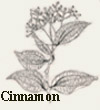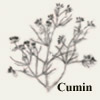| Herbal
plants and medicinal properties |
|
CARDAMOM
Botanical Name - Ellettaria Cardamom
Indian Name - Chhoti elaichi
Cardamom is the 'queen of spices'. It is one of the most valued
spices in the world. Cardamom grows as the perennial herb with
thick, fleshy rhizomes or underground stems shooting leafy roots
and with leafy stems. It has very large leaves, white or pale
green tree -celled flowers, many-seeded pale green to yellow
fruits and triangular brownish-black seeds.
|
Properties :- The aroma and therapeutic properties of cardamom
are due to its volatile oil. Tinctures of cardamom are used
chiefly in medicines to relieve flatulence and for strengthening
digestion activities.
|
CARAWAY
SEEDS
Botanical Name - Carum carvi
Indian Name - Siya jeera
|
 |
The
caraway plant is a biennial herb usually with a fleshy
root and slender, branched stems. It has feather- like
leaves like leaves divided into very narrow segments small
white flowers. The fruit, when ripe, splits into narrow,
elongated carples, which are curved, pointed at the ends
and have four longitudinal ridges on the surface. The
analysis of caraway seeds shows it to contain appreciable
moisture, protein, fat, substantial amount of carvone,
is obtained from caraway seeds. This oil is colorless
or pale with a strong odour and flavors of the fruit. |
|
Properties :- The caraway seeds, leaves and roots are considered
useful in activating the glands, besides increasing the action
of the kidneys. It is characterized as an excellent 'house cleaner'
for the body. Caraway oil is used in medicine to relieve flatulence.
|
CASSIA
Botanical Name :- Cassia fistula
Indian Name :- Amaltas
Cassia or purging cassia is one of the most beautiful trees
of India. It is a small to medium-sized tree with compound leaves
and large , shining , dark green leaflets. It has bright yellow
flowers in very large, hanging branches and black or shining
dark brown, 50 to 60 cm. long almost cylindrical fruits. The
tree is known as Indian Laburnum owing to its resemblance in
colour and profusion of flowers with the European Laburnum.
The trade name is based on its scientific name but the specific
name fistula, which means a shepherd's pipe, refers to the shape
of its fruit.
|
| Properties
:-All the parts of the tree have medical properties. The fruits
are, however most important and are included in the Indian Pharmaceutical
codex. Its is commonly used for cold, fever, intestinal disorders,
aguesia and skin disorders. |
CELERY
Botanical Name :- Apium graveolens
Indian Name :- Ajmod or Ajwain-ka-patta
Celery is an important salad plant, consisting of the bulbous
roots, green leaves and stem. The leaves sprout directly from
the fleshy roots. The fruits are small in size, dark brown in
colour and have a peculiar flavour when cut open. The seeds
are brown in colour. celery has been in cultivation for more
than 2,000 years. It was known to the Chinese from the fifth
century B.C . In England , it was known as smallage and used
in medicines. It is a native of Europe and Asia.
|
| Properties
:- Celery which means quick acting ,and presumably refers to
its therapeutic properties. The green leaves and stem of the
bulbous roots are all extremely rich in active ingredients that
make celery an important medical plant. It has a well balanced
content of a basic minerals , vitamins and nutrients, besides
a good concentration of plant hormones and essential oils that
gives celery its strong and characteristic smell. These oils
have a specific effect on the regulation of the nervous system
with their tranquilizing properties. They are tonic , laxative
and stimulant. They correct spasmodic disorders and can be used
for aborting unwanted pregnancies. |
CHICORY
Botanical Name :-Chichorium intybus
Indian Name :-Kasni
Chicory is a perennial herb with a long tap root. Chicory is
a native to the Mediterranean region or possibly eastern India.
Chicory has been mentioned as a special skin nourisher by ancient
herbalists. A tea made from the pale blue flowers of this plant
was said to give glowing skin.
|
| Properties
:- Chicory is a tonic herb when taken in moderate quantities
. It increases the secretion and discharge of urine. It is also
a stimulant and mild laxative . This herb helps the functions
of liver and gall bladder. Chicory contains food elements which
are constantly needed by the optic system. It is one of the
richest source of Vitamin A which is very useful for the eyes.
This herb is also used for the treatment of Anemia, Liver complaints,
respiratory disorders and Obstructed Menstruation. |
CINNAMON
Botanical Name :- Cinnamomum zeylanicum
Indian Name :- Dalchini
|
| Cinnamon
is an evergreen tree which is small and bushy. Dried leaves
of cinnamon, along with its dried inner bark are used
all over the as a spice or condiment. The bark of a tree
is thick, smooth and light or dark brownish in colour.
The inner bark is obtained from carefully selected shoots.
Cinnamon tree was known to ancient physicians even before
27 BC. The Chinese used the bark of this tree is a medicine.
Cinnamon is a native of Sri Lanka and Asia. An analysis
of Cinnamon shows it to consist of moisture, protein,
fat, fibre, carbohydrates and ash , iron, sodium, potassium,
niacin, Vitamin A and C. Cinnamon also contains an essential
oil known as cinnamon oil. |
 |
|
| Properties
:- Cinnamon leaves are used in the form of powder or decoction.
They are stimulant and useful in relieving flatulence and in
increasing secretion and discharge of urine. Cinnamon prevents
nervous tension, improves complexion and memory. Cinnamon is
an effective medicine for common cold. Cinnamon checks nausea,
vomiting and diarrhoea. It stimulates digestion. Cinnamon serves
as a good mouth freshner. It is also useful headache and Acne. |
CORIANDER
Botanical Name :- Coriandrum sativum
Indian Name :- Dhania
Coriander is both an annual and perennial herb. It is erect
, sweet smelling and grows up to 20 cms in length with many
branches. The stem is feeble, smooth and light green in colour.
Leaves are compound, thin, and easily breakable. They have a
sweet fragrance.
|
.
Properties:- The leaves of coriander are stimulant and tonic.
they strengthen the stomach and promote its action, relieve
flatulence, increase secretion and discharge of urine and reduce
fever.
|
CUMIN
SEEDS
Botanical Name :- Cuminum cyminum
Indian Name :- Jeera
|
 |
Cumin
is an annual herb with a smooth surface and long slender
root. It grows up to the height of 356 to 40 cm.
It produces a stem with many branches. The dried seed
forms an essential ingredient of curry powder. Cumin is
a native of Egypt, Syria, Turkey and the Eastern Mediterranean
region. It was one of the common spices used in the middle
ages. The analysis of cumin seeds shows them to consist
of moisture 6.2 %, protein 17.7% , fat 23.8 % , fibre
9.1% , carbohydrates 35.5 and mineral matter 7.7% per
100 gms. Their minerals and vitamin contains are calcium,
phosphorus, iron, sodium, potassium , Vitamins C &
vitamin A. |
|
| Properties
:- The fruit is a rich source of thymol. Thymol is used as an
anthelmintic against hookworm infections and also as an antiseptic
in many proporietary preparations. It is a stimulant, which
increases the secretion and discharge of urine and relieves
flatulence. |
CURRY
LEAVES
Botanical Name :- Murraya koenigi
Indian Name :- Curry patta
Curry leaves are derived from beautiful, aromatic and more or
less deciduous shrub growing up to 0.9 metres, or a small downy
tree, up 6 meters in height and 15 to 40 cms. in diameter. The
leave are slightly bitter and aromatic. The curry tree is a
native of India and Sri Lanka. Their minerals and vitamin contents
are calcium ,phosphorus, iron, nicotinic acid and Vitamin C.
Fresh leaves on steam distillation under pressure yield a volatile
|
| Properties
:- Curry leaves possess the qualities of a herbal tonic . they
strengthen the functions of stomach and promote its action.
They are also used as a mild laxative. The leaves may be taken
mixed with other mild tasting herbs. It is used for digestive
disorders, diabetes, burns & bruises, eye disorders, insect
bites etc. |